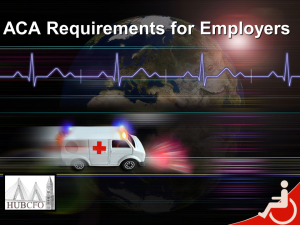ACA Requirements for Employers

The health care law contains tax provisions that affect employers. The size and structure of a workforce–small or large–helps determine which parts of the law apply to which employers. Calculating the number of employees is especially important for employers that have close to 50 employees or whose workforce fluctuates during the year.
Two parts of the Affordable Care Act apply only to applicable large employers. These are the employer shared responsibility provisions and the employer information reporting provisions for offers of minimum essential coverage.
The number of employees an employer has during the current year determines whether it is an applicable large employer (ALE) for the following year. For example, you will use information about the size of your workforce during 2016 to determine if your organization is an ALE for 2017.
Applicable large employers are generally those with 50 or more full-time employees or full-time equivalent employees. Under the employer shared responsibility provision, ALEs are required to offer their full-time employees and dependents affordable coverage that provides minimum value. Employers with fewer than 50 full-time or full-time equivalent employees are not applicable large employers.
Who is a Full-time Employee?
There are many additional rules on determining who is a full-time employee, including what counts as hours of service, but in general:
- A full-time employee is an employee who is employed on average, per month, at least 30 hours of service per week, or at least 130 hours of service in a calendar month.
- A full-time equivalent employee is a combination of employees, each of whom individually is not a full-time employee, but who, in combination, are equivalent to a full-time employee.
- An aggregated group is commonly owned or otherwise related or affiliated employers, which must combine their employees to determine their workforce size.
Figuring the Size of the Workforce
To determine your workforce size for a year, you add your total number of full-time employees for each month of the prior calendar year to the total number of full-time equivalent employees for each calendar month of the prior calendar year and divide that total number by 12. If the result is 50 or more employees, you are an applicable large employer.
Employers with Fewer than 50 Employees
If an employer has fewer than 50 full-time employees, including full-time equivalent employees, on average during the prior year, the employer is not an ALE for the current calendar year. Therefore, the employer is not subject to the employer shared responsibility provisions or the employer information reporting provisions for the current year.
Information Reporting (Including Self-Insured Employers)
All providers of health coverage, including employers that provide self-insured coverage, must file annual returns with the IRS reporting information about the coverage and about each covered individual. The coverage is reported on a Form 1095-B, Health Coverage and the employer must also furnish a copy of Form 1095-B to the employee by March 2, 2017.
Tax Credits
Certain employers may be eligible for the small business health care tax credit if they:
- cover at least 50 percent of employees’ premium costs
- have fewer than 25 full-time equivalent employees with average annual wages of less than $52,000 in 2016 (indexed for inflation)
- purchase their coverage through the Small Business Health Options Program.
Employers with fewer than 50 full-time employees or full-time equivalent employees are not subject to the employer shared responsibility provisions.
Employers with 50 or More Employees
Information Reporting
All employers including applicable large employers that provide self-insured health coverage must file an annual return for individuals they cover, and provide a statement to responsible individuals.
Applicable large employers must file an annual return–and provide a statement to each full-time employee–reporting whether they offered health insurance, and if so, what insurance they offered their employees.
ALEs are required to furnish a statement to each full-time employee that includes the same information provided to the IRS by March 2, 2017. ALEs that file 250 or more information returns during the calendar year must file the returns electronically.
Employer Shared Responsibility Payment
ALEs are subject to the employer shared responsibility payment if at least one full-time employee receives the premium tax credit and any one these conditions apply. The ALE:
- failed to offer coverage to full-time employees and their dependents
- offered coverage that was not affordable
- offered coverage that did not provide a minimum level of coverage
Questions? Don’t hesitate to call for assistance.
Website www.HubCFO.com
Blog www.Blog.HubCFO.com
Twitter https://twitter.com/HubCFO_LLC
LinkedIn https://www.linkedin.com/company/hubcfo
Facebook https://www.facebook.com/Hub-CFO
Google+ https://plus.google.com/+Hubcfo
